- What Is Python? An Introduction
- What Is The History Of Python?
- Key Features Of The Python Programming Language
- Who Uses Python?
- Basic Characteristics Of Python Programming Syntax
- Why Should You Learn Python?
- Applications Of Python Language
- Advantages And Disadvantages Of Python
- Some Useful Python Tips & Tricks For Efficient Programming
- Python 2 Vs. Python 3: Which Should You Learn?
- Python Libraries
- Conclusion
- Frequently Asked Questions
- It's Python Basics Quiz Time!
- What is Python & its Brief History
- Key Features of Python Programming Language
- Applications of Python Language
- Practical Python Code Examples
- About Python IDLE
- Comparative Features of Python, Java, & C++
- Conclusion
- Frequently Asked Questions
- Take A Quiz To Rehash Python's Features!
- What Is Python IDLE?
- What Is Python Shell & Its Uses?
- Primary Features Of Python IDLE
- How To Use Python IDLE Shell? Setting Up Your Python Environment
- How To Work With Files In Python IDLE?
- How To Execute A File In Python IDLE?
- Improving Workflow In Python IDLE Software
- Debugging In Python IDLE
- Customizing Python IDLE
- Code Examples
- Conclusion
- Frequently Asked Questions (FAQs)
- How Well Do You Know IDLE? Take A Quiz!
- What Is A Variable In Python?
- Creating And Declaring Python Variables
- Rules For Naming Python Variables
- How To Print Python Variables?
- How To Delete A Python Variable?
- Various Methods Of Variables Assignment In Python
- Python Variable Types
- Python Variable Scope
- Concatenating Python Variables
- Object Identity & Object References Of Python Variables
- Reserved Words/ Keywords & Python Variable Names
- Conclusion
- Frequently Asked Questions
- Rehash Python Variables Basics With A Quiz!
- What Is A String In Python?
- Creating String In Python
- How To Create Multiline Python Strings?
- Reassigning Python Strings
- Accessing Characters Of Python Strings
- How To Update Or Delete A Python String?
- Reversing A Python String
- Formatting Python Strings
- Concatenation & Comparison Of Python Strings
- Python String Operators
- Python String Functions
- Escape Sequences In Python Strings
- Conclusion
- Frequently Asked Questions
- Rehash Python Strings Basics With A Quiz!
- What Is Python Namespace?
- Lifetime Of Python Namespace
- Types Of Python Namespace
- The Built-In Namespace In Python
- The Global Namespace In Python
- The Local Namespace In Python
- The Enclosing Namespace In Python
- Variable Scope & Namespace In Python
- Python Namespace Dictionaries
- Changing Variables Out Of Their Scope & Python Namespace
- Best Practices Of Python Namespace
- Conclusion
- Frequently Asked Questions
- Test Your Knowledge Of Python Namespaces!
- What Are Logical Operators In Python?
- The AND Python Logical Operator
- The OR Python Logical Operator
- The NOT Python Logical Operator
- Short-Circuiting Evaluation Of Python Logical Operators
- Precedence of Logical Operators In Python
- How Does Python Calculate Truth Value?
- Final Note On How AND & OR Python Logical Operators Work
- Conclusion
- Frequently Asked Questions
- Python Logical Operators Quiz– Test Your Knowledge!
- What Are Bitwise Operators In Python?
- List Of Python Bitwise Operators
- AND Python Bitwise Operator
- OR Python Bitwise Operator
- NOT Python Bitwise Operator
- XOR Python Bitwise Operator
- Right Shift Python Bitwise Operator
- Left Shift Python Bitwise Operator
- Python Bitwise Operations On Negative Integers
- The Binary Number System
- Application of Python Bitwise Operators
- Python Bitwise Operator Overloading
- Conclusion
- Frequently Asked Questions
- Test Your Knowledge Of Python Bitwise Operators!
- What Is The Print() Function In Python?
- How Does The print() Function Work In Python?
- How To Print Single & Multi-line Strings In Python?
- How To Print Built-in Data Types In Python?
- Print() Function In Python For Values Stored In Variables
- Print() Function In Python With sep Parameter
- Print() Function In Python With end Parameter
- Print() Function In Python With flush Parameter
- Print() Function In Python With file Parameter
- How To Remove Newline From print() Function In Python?
- Use Cases Of The print() Function In Python
- Understanding Print Statement In Python 2 Vs. Python 3
- Conclusion
- Frequently Asked Questions
- Know The print() Function In Python? Take A Quiz!
- Working Of Normal Print() Function
- The New Line Character In Python
- How To Print Without Newline In Python | Using The End Parameter
- How To Print Without Newline In Python 2.x? | Using Comma Operator
- How To Print Without Newline In Python 3.x?
- How To Print Without Newline In Python With Module Sys
- The Star Pattern(*) | How To Print Without Newline & Space In Python
- How To Print A List Without Newline In Python?
- How To Remove New Lines In Python?
- Conclusion
- Frequently Asked Questions
- Think You Can Print Without a Newline in Python? Prove It!
- What Is A Python For Loop?
- How Does Python For Loop Work?
- When & Why To Use Python For Loops?
- Python For Loop Examples
- What Is Rrange() Function In Python?
- Nested For Loops In Python
- Python For Loop With Continue & Break Statements
- Python For Loop With Pass Statement
- Else Statement In Python For Loop
- Conclusion
- Frequently Asked Questions
- Think You Know Python's For Loop? Prove It!
- What Is Python While Loop?
- How Does The Python While Loop Work?
- How To Use Python While Loops For Iterations?
- Control Statements In Python While Loop With Examples
- Python While Loop With Python List
- Infinite Python While Loop in Python
- Python While Loop Multiple Conditions
- Nested Python While Loops
- Conclusion
- Frequently Asked Questions
- Mastered Python While Loop? Let’s Find Out!
- What Are Conditional If-Else Statements In Python?
- Types Of If-Else Statements In Python
- If Statement In Python
- If-Else Statement In Python
- Nested If-Else Statement In Python
- Elif Statement In Python
- Ladder If-Elif-Else Statement In Python
- Short Hand If-Statement In Python
- Short Hand If-Else Statement In Python
- Operators & If-Esle Statement In Python
- Other Statements With If-Else In Python
- Conclusion
- Frequently Asked Questions
- Quick If-Else Statement Quiz– Let’s Go!
- What Is Control Structure In Python?
- Types Of Control Structures In Python
- Sequential Control Structures In Python
- Decision-Making Control Structures In Python
- Repetition Control Structures In Python
- Benefits Of Using Control Structures In Python
- Conclusion
- Frequently Asked Questions
- Control Structures in Python – Are You the Master? Take A Quiz!
- What Are Python Libraries?
- How Do Python Libraries Work?
- Standard Python Libraries (With List)
- Important Python Libraries For Data Science
- Important Python Libraries For Machine & Deep Learning
- Other Important Python Libraries You Must Know
- Working With Third-Party Python Libraries
- Troubleshooting Common Issues For Python Libraries
- Python Libraries In Larger Projects
- Importance Of Python Libraries
- Conclusion
- Frequently Asked Questions
- Quick Quiz On Python Libraries – Let’s Go!
- What Are Python Functions?
- How To Create/ Define Functions In Python?
- How To Call A Python Function?
- Types Of Python Functions Based On Parameters & Return Statement
- Rules & Best Practices For Naming Python Functions
- Basic Types of Python Functions
- The Return Statement In Python Functions
- Types Of Arguments In Python Functions
- Docstring In Python Functions
- Passing Parameters In Python Functions
- Python Function Variables | Scope & Lifetime
- Advantages Of Using Python Functions
- Recursive Python Function
- Anonymous/ Lambda Function In Python
- Nested Functions In Python
- Conclusion
- Frequently Asked Questions
- Python Functions – Test Your Knowledge With A Quiz!
- What Are Python Built-In Functions?
- Mathematical Python Built-In Functions
- Python Built-In Functions For Strings
- Input/ Output Built-In Functions In Python
- List & Tuple Python Built-In Functions
- File Handling Python Built-In Functions
- Python Built-In Functions For Dictionary
- Type Conversion Python Built-In Functions
- Basic Python Built-In Functions
- List Of Python Built-In Functions (Alphabetical)
- Conclusion
- Frequently Asked Questions
- Think You Know Python Built-in Functions? Prove It!
- What Is A round() Function In Python?
- How Does Python round() Function Work?
- Python round() Function If The Second Parameter Is Missing
- Python round() Function If The Second Parameter Is Present
- Python round() Function With Negative Integers
- Python round() Function With Math Library
- Python round() Function With Numpy Module
- Round Up And Round Down Numbers In Python
- Truncation Vs Rounding In Python
- Practical Applications Of Python round() Function
- Conclusion
- Frequently Asked Questions
- Revisit Python’s round() Function – Take The Quiz!
- What Is Python pow() Function?
- Python pow() Function Example
- Python pow() Function With Modulus (Three Parameters)
- Python pow() Function With Complex Numbers
- Python pow() Function With Floating-Point Arguments And Modulus
- Python pow() Function Implementation Cases
- Difference Between Inbuilt-pow() And math.pow() Function
- Conclusion
- Frequently Asked Questions
- Test Your Knowledge Of Python’s pow() Function!
- Python max() Function With Objects
- Examples Of Python max() Function With Objects
- Python max() Function With Iterable
- Examples Of Python max() Function With Iterables
- Potential Errors With The Python max() Function
- Python max() Function Vs. Python min() Functions
- Conclusion
- Frequently Asked Questions
- Think You Know Python max() Function? Take A Quiz!
- What Are Strings In Python?
- What Are Python String Methods?
- List Of Python String Methods For Manipulating Case
- List Of Python String Methods For Searching & Finding
- List Of Python String Methods For Modifying & Transforming
- List Of Python String Methods For Checking Conditions
- List Of Python String Methods For Encoding & Decoding
- List Of Python String Methods For Stripping & Trimming
- List Of Python String Methods For Formatting
- Miscellaneous Python String Methods
- List Of Other Python String Operations
- Conclusion
- Frequently Asked Questions
- Mastered Python String Methods? Take A Quiz!
- What Is Python String?
- The Need For Python String Replacement
- The Python String replace() Method
- Multiple Replacements With Python String.replace() Method
- Replace A Character In String Using For Loop In Python
- Python String Replacement Using Slicing Method
- Replace A Character At a Given Position In Python String
- Replace Multiple Substrings With The Same String In Python
- Python String Replacement Using Regex Pattern
- Python String Replacement Using List Comprehension & Join() Method
- Python String Replacement Using Callback With re.sub() Method
- Python String Replacement With re.subn() Method
- Conclusion
- Frequently Asked Questions
- Know How To Replace Python Strings? Prove It!
- What Is String Slicing In Python?
- How Indexing & String Slicing Works In Python
- Extracting All Characters Using String Slicing In Python
- Extracting Characters Before & After Specific Position Using String Slicing In Python
- Extracting Characters Between Two Intervals Using String Slicing In Python
- Extracting Characters At Specific Intervals (Step) Using String Slicing In Python
- Negative Indexing & String Slicing In Python
- Handling Out-of-Bounds Indices In String Slicing In Python
- The slice() Method For String Slicing In Python
- Common Pitfalls Of String Slicing In Python
- Real-World Applications Of String Slicing
- Conclusion
- Frequently Asked Questions
- Quick Python String Slicing Quiz– Let’s Go!
- Introduction To Python List
- How To Create A Python List?
- How To Access Elements Of Python List?
- Accessing Multiple Elements From A Python List (Slicing)
- Access List Elements From Nested Python Lists
- How To Change Elements In Python Lists?
- How To Add Elements To Python Lists?
- Delete/ Remove Elements From Python Lists
- How To Create Copies Of Python Lists?
- Repeating Python Lists
- Ways To Iterate Over Python Lists
- How To Reverse A Python List?
- How To Sort Items Of Python Lists?
- Built-in Functions For Operations On Python Lists
- Conclusion
- Frequently Asked Questions
- Revisit Python Lists Basics With A Quick Quiz!
- What Is List Comprehension In Python?
- Incorporating Conditional Statements With List Comprehension In Python
- List Comprehension In Python With range()
- Filtering Lists Effectively With List Comprehension In Python
- Nested Loops With List Comprehension In Python
- Flattening Nested Lists With List Comprehension In Python
- Handling Exceptions In List Comprehension In Python
- Common Use Cases For List Comprehensions
- Advantages & Disadvantages Of List Comprehension In Python
- Best Practices For Using List Comprehension In Python
- Performance Considerations For List Comprehension In Python
- For Loops & List Comprehension In Python: A Comparison
- Difference Between Generator Expression & List Comprehension In Python
- Conclusion
- Frequently Asked Questions
- Rehash Python List Comprehension Basics With A Quiz!
- What Is A List In Python?
- How To Find Length Of List In Python?
- For Loop To Get Python List Length (Naive Approach)
- The len() Function To Get Length Of List In Python
- The length_hint() Function To Find Length Of List In Python
- The sum() Function To Find The Length Of List In Python
- The enumerate() Function To Find Python List Length
- The Counter Class From collections To Find Python List Length
- The List Comprehension To Find Python List Length
- Find The Length Of List In Python Using Recursion
- Comparison Between Ways To Find Python List Length
- Conclusion
- Frequently Asked Questions
- Know How To Get Python List Length? Prove it!
- List of Methods To Reverse A Python List
- Python Reverse List Using reverse() Method
- Python Reverse List Using the Slice Operator ([::-1])
- Python Reverse List By Swapping Elements
- Python Reverse List Using The reversed() Function
- Python Reverse List Using A for Loop
- Python Reverse List Using While Loop
- Python Reverse List Using List Comprehension
- Python Reverse List Using List Indexing
- Python Reverse List Using The range() Function
- Python Reverse List Using NumPy
- Comparison Of Ways To Reverse A Python List
- Conclusion
- Frequently Asked Questions
- Time To Test Your Python List Reversal Skills!
- What Is Indexing In Python?
- The Python List index() Function
- How To Use Python List index() To Find Index Of A List Element
- The Python List index() Method With Single Parameter (Start)
- The Python List index() Method With Start & Stop Parameters
- What Happens When We Use Python List index() For An Element That Doesn't Exist
- Python List index() With Nested Lists
- Fixing IndexError Using The Python List index() Method
- Python List index() With Enumerate()
- Real-world Examples Of Python List index() Method
- Difference Between find() And index() Method In Python
- Conclusion
- Frequently Asked Questions
- Think You Know Python List Indexing? Take A Quiz!
- How To Remove Elements From List In Python?
- The remove() Method To Remove Element From Python List
- The pop() Method To Remove Element From List In Python
- The del Keyword To Remove Element From List In Python
- The clear() Method To Remove Elements From Python List
- List Comprehensions To Conditionally Remove Element From List In Python
- Key Considerations For Removing Elements From Python Lists
- Why We Need to Remove Elements From Python List
- Performance Comparison Of Methods To Remove Element From List In Python
- Conclusion
- Frequently Asked Questions
- Quiz– Prove You Know How To Remove Item From Python Lists!
- How To Remove Duplicates From A List In Python?
- The set() Function To Remove Duplicates From Python List
- Remove Duplicates From Python List Using For Loop
- Using List Comprehension Remove Duplicates From Python List
- Remove Duplicates From Python List Using enumerate() With List Comprehension
- Dictionary & fromkeys() Method To Remove Duplicates From Python List
- Remove Duplicates From Python List Using in, not in Operators
- Remove Duplicates From Python List Using collections.OrderedDict.fromkeys()
- Remove Duplicates From Python List Using Counter with freq.dist() Method
- The del Keyword Remove Duplicates From Python List
- Remove Duplicates From Python List Using DataFrame
- Remove Duplicates From Python List Using pd.unique and np.unipue
- Remove Duplicates From Python List Using reduce() function
- Comparative Analysis Of Ways To Remove Duplicates From Python List
- Conclusion
- Frequently Asked Questions
- Think You Know How to Remove Duplicates? Take A Quiz!
- What Is Python List & How To Access Elements?
- What Is IndexError: List Index Out Of Range & Its Causes In Python?
- Understanding Indexing Behavior In Python Lists
- How to Prevent/ Fix IndexError: List Index Out Of Range In Python
- Handling IndexError Gracefully Using Try-Except
- Debugging Tips For IndexError: List Index Out Of Range Python
- Conclusion
- Frequently Asked Questions
- Avoiding ‘List Index Out of Range’ Errors? Take A Quiz!
- What Is the Python sort() List Method?
- Sorting In Ascending Order Using The Python sort() List Method
- How To Sort Items In Descending Order Using Python sort() List Method
- Custom Sorting Using The Key Parameter Of Python sort() List Method
- Examples Of Python sort() List Method
- What Is The sorted() List Method In Python
- Differences Between sorted() And sort() List Methods In Python
- When To Use sorted() & When To Use sort() List Method In Python
- Conclusion
- Frequently Asked Questions
- Take A Quick Python's sort() Quiz!
- What Is A List In Python?
- What Is A String In Python?
- Why Convert Python List To String?
- How To Convert List To String In Python?
- The join() Method To Convert Python List To String
- Convert Python List To String Through Iteration
- Convert Python List To String With List Comprehension
- The map() Function To Convert Python List To String
- Convert Python List to String Using format() Function
- Convert Python List To String Using Recursion
- Enumeration Function To Convert Python List To String
- Convert Python List To String Using Operator Module
- Python Program To Convert String To List
- Conclusion
- Frequently Asked Questions
- Convert Lists To Strings Like A Pro! Take A Quiz
- What Is Inheritance In Python?
- Python Inheritance Syntax
- Parent Class In Python Inheritance
- Child Class In Python Inheritance
- The __init__() Method In Python Inheritance
- The super() Function In Python Inheritance
- Method Overriding In Python Inheritance
- Types Of Inheritance In Python
- Special Functions In Python Inheritance
- Advantages & Disadvantages Of Inheritance In Python
- Common Use Cases For Inheritance In Python
- Best Practices for Implementing Inheritance in Python
- Avoiding Common Pitfalls in Python Inheritance
- Conclusion
- Frequently Asked Questions
- 💡 Python Inheritance Quiz – Are You Ready?
- What Is The Python List append() Method?
- Adding Elements To A Python List Using append()
- Populate A Python List Using append()
- Adding Different Data Types To Python List Using append()
- Adding A List To Python List Using append()
- Nested Lists With Python List append() Method
- Practical Use Cases Of Python List append() Method
- How append() Method Affects List Performance
- Avoiding Common Mistakes When Using Python List append()
- Comparing extend() With append() Python List Method
- Conclusion
- Frequently Asked Questions
- 🧠 Think You Know Python List append()? Take A Quiz!
- What Is A Linked List In Python?
- Types Of Linked Lists In Python
- How To Create A Linked List In Python
- How To Traverse A Linked List In Python & Retrieve Elements
- Inserting Elements In A Linked List In Python
- Deleting Elements From A Linked List In Python
- Update A Node Of Linked List In Python
- Reversing A Linked List In Python
- Calculating Length Of A Linked List In Python
- Comparing Arrays And Linked Lists In Python
- Advantages & Disadvantages Of Linked List In Python
- When To Use Linked Lists Over Other Data Structures
- Practical Applications Of Linked Lists In Python
- Conclusion
- Frequently Asked Questions
- 🔗 Linked List Logic: Can You Ace This Quiz?
- What Is Extend In Python?
- Extend In Python With List
- Extend In Python With String
- Extend In Python With Tuple
- Extend In Python With Set
- Extend In Python With Dictionary
- Other Methods To Extend A List In Python
- Difference Between append() and extend() In Python
- Conclusion
- Frequently Asked Questions
- Think You Know extend() In Python? Prove It!
- What Is Recursion In Python?
- Key Components Of Recursive Functions In Python
- Implementing Recursion In Python
- Recursion Vs. Iteration In Python
- Tail Recursion In Python
- Infinite Recursion In Python
- Advantages Of Recursion In Python
- Disadvantages Of Recursion In Python
- Best Practices For Using Recursion In Python
- Conclusion
- Frequently Asked Questions
- Recursive Thinking In Python: Test Your Skills!
- What Is Type Conversion In Python?
- Types Of Type Conversion In Python
- Implicit Type Conversion In Python
- Explicit Type Conversion In Python
- Functions Used For Explicit Data Type Conversion In Python
- Important Type Conversion Tips In Python
- Benefits Of Type Conversion In Python
- Conclusion
- Frequently Asked Questions
- Think You Know Type Conversion? Take A Quiz!
- What Is Scope In Python?
- Local Scope In Python
- Global Scope In Python
- Nonlocal (Enclosing) Scope In Python
- Built-In Scope In Python
- The LEGB Rule For Python Scope
- Python Scope And Variable Lifetime
- Best Practices For Managing Python Scope
- Conclusion
- Frequently Asked Questions
- Think You Know Python Scope? Test Yourself!
- Understanding The Continue Statement In Python
- How Does Continue Statement Work In Python?
- Python Continue Statement With For Loops
- Python Continue Statement With While Loops
- Python Continue Statement With Nested Loops
- Python Continue With If-Else Statement
- Difference Between Pass and Continue Statement In Python
- Practical Applications Of Continue Statement In Python
- Conclusion
- Frequently Asked Questions
- Python 'continue' Statement Quiz: Can You Ace It?
- What Are Control Statements In Python?
- Types Of Control Statements In Python
- Conditional Control Statements In Python
- Loop Control Statements In Python
- Control Flow Altering Statements In Python
- Exception Handling Control Statements In Python
- Conclusion
- Frequently Asked Questions
- Mastering Control Statements In Python – Take the Quiz!
- Difference Between Mutable And Immutable Data Types in Python
- What Is Mutable Data Type In Python?
- Types Of Mutable Data Types In Python
- What Are Immutable Data Types In Python?
- Types Of Immutable Data Types In Python
- Key Similarities Between Mutable And Immutable Data Types In Python
- When To Use Mutable Vs Immutable In Python?
- Conclusion
- Frequently Asked Questions
- Quiz Time: Mutable vs. Immutable In Python!
- What Is A List?
- What Is A Tuple?
- Difference Between List And Tuple In Python (Comparison Table)
- Syntax Difference Between List And Tuple In Python
- Mutability Difference Between List And Tuple In Python
- Other Difference Between List And Tuple In Python
- List Vs. Tuple In Python | Methods
- When To Use Tuples Over Lists?
- Key Similarities Between Tuples And Lists In Python
- Conclusion
- Frequently Asked Questions
- 🧐 Lists vs. Tuples Quiz: Test Your Python Knowledge!
- Introduction to Python
- Downloading & Installing Python, IDLE, Tkinter, NumPy & PyGame
- Creating A New Python Project
- How To Write Python Hello World Program In Python?
- Way To Write The Hello, World! Program In Python
- The Hello, World! Program In Python Using Class
- The Hello, World! Program In Python Using Function
- Print Hello World 5 Times Using A For Loop
- Conclusion
- Frequently Asked Questions
- 👋 Python's 'Hello, World!'—How Well Do You Know It?
- Algorithm Of Python Program To Add To Numbers
- Standard Program To Add Two Numbers In Python
- Python Program To Add Two Numbers With User-defined Input
- The add() Method In Python Program To Add Two Numbers
- Python Program To Add Two Numbers Using Lambda
- Python Program To Add Two Numbers Using Function
- Python Program To Add Two Numbers Using Recursion
- Python Program To Add Two Numbers Using Class
- How To Add Multiple Numbers In Python?
- Add Multiple Numbers In Python With User Input
- Time Complexities Of Python Programs To Add Two Numbers
- Conclusion
- Frequently Asked Questions
- 💡 Quiz Time: Python Addition Basics!
- Swapping in Python
- Swapping Two Variables Using A Temporary Variable
- Swapping Two Variables Using The Comma Operator In Python
- Swapping Two Variables Using The Arithmetic Operators (+,-)
- Swapping Two Variables Using The Arithmetic Operators (*,/)
- Swapping Two Variables Using The XOR(^) Operator
- Swapping Two Variables Using Bitwise Addition and Subtraction
- Swap Variables In A List
- Conclusion
- Frequently Asked Questions (FAQs)
- Quiz To Test Your Variable Swapping Knowledge
- What Is A Quadratic Equation? How To Solve It?
- How To Write A Python Program To Solve Quadratic Equations?
- Python Program To Solve Quadratic Equations Directly Using The Formula
- Python Program To Solve Quadratic Equations Using The Complex Math Module
- Python Program To Solve Quadratic Equations Using Functions
- Python Program To Solve Quadratic Equations & Find Number Of Solutions
- Python Program To Plot Quadratic Functions
- Conclusion
- Frequently Asked Questions
- Quadratic Equations In Python Quiz: Test Your Knowledge!
- What Is Decimal Number System?
- What Is Binary Number System?
- What Is Octal Number System?
- What Is Hexadecimal Number System?
- Python Program to Convert Decimal to Binary, Octal, And Hexadecimal Using Built-In Function
- Python Program To Convert Decimal To Binary Using Recursion
- Python Program To Convert Decimal To Octal Using Recursion
- Python Program To Convert Decimal To Hexadecimal Using Recursion
- Python Program To Convert Decimal To Binary Using While Loop
- Python Program To Convert Decimal To Octal Using While Loop
- Python Program To Convert Decimal To Hexadecimal Using While Loop
- Convert Decimal To Binary, Octal, And Hexadecimal Using String Formatting
- Python Program To Convert Binary, Octal, And Hexadecimal String To A Number
- Complexity Comparison Of Python Programs To Convert Decimal To Binary, Octal, And Hexadecimal
- Conclusion
- Frequently Asked Questions
- 💡 Decimal To Binary, Octal & Hex: Quiz Time!
- What Is A Square Root?
- Python Program To Find The Square Root Of A Number
- The pow() Function In Python Program To Find The Square Root Of Given Number
- Python Program To Find Square Root Using The sqrt() Function
- The cmath Module & Python Program To Find The Square Root Of A Number
- Python Program To Find Square Root Using The Exponent Operator (**)
- Python Program To Find Square Root With A User-Defined Function
- Python Program To Find Square Root Using A Class
- Python Program To Find Square Root Using Binary Search
- Python Program To Find Square Root Using NumPy Module
- Conclusion
- Frequently Asked Questions
- 🤓 Think You Know Square Roots In Python? Take A Quiz!
- Understanding the Logic Behind the Conversion of Kilometers to Miles
- Steps To Write Python Program To Convert Kilometers To Miles
- Python Program To Convert Kilometer To Miles Without Function
- Python Program To Convert Kilometer To Miles Using Function
- Python Program to Convert Kilometer To Miles Using Class
- Tips For Writing Python Program To Convert Kilometer To Miles
- Conclusion
- Frequently Asked Questions
- 🧐 Mastered Kilometer To Mile Conversion? Prove It!
- Why Build A Calculator Program In Python?
- Prerequisites To Writing A Calculator Program In Python
- Approach For Writing A Calculator Program In Python
- Simple Calculator Program In Python
- Calculator Program In Python Using Functions
- Creating GUI Calculator Program In Python Using Tkinter
- Conclusion
- Frequently Asked Questions
- 🧮 Calculator Program In Python Quiz!
- The Calendar Module In Python
- Prerequisites For Writing A Calendar Program In Python
- How To Write And Print A Calendar Program In Python
- Calendar Program In Python To Display A Month
- Calendar Program In Python To Display A Year
- Conclusion
- Frequently Asked Questions
- Calendar Program In Python – Quiz Time!
- What Is The Fibonacci Series?
- Pseudocode Code For Fibonacci Series Program In Python
- Generating Fibonacci Series In Python Using Naive Approach (While Loop)
- Fibonacci Series Program In Python Using The Direct Formula
- How To Generate Fibonacci Series In Python Using Recursion?
- Generating Fibonacci Series In Python With Dynamic Programming
- Fibonacci Series Program In Python Using For Loop
- Generating Fibonacci Series In Python Using If-Else Statement
- Generating Fibonacci Series In Python Using Arrays
- Generating Fibonacci Series In Python Using Cache
- Generating Fibonacci Series In Python Using Backtracking
- Fibonacci Series In Python Using Power Of Matix
- Complexity Analysis For Fibonacci Series Programs In Python
- Applications Of Fibonacci Series In Python & Programming
- Conclusion
- Frequently Asked Questions
- 🤔 Think You Know Fibonacci Series? Take A Quiz!
- Different Ways To Write Random Number Generator Python Programs
- Random Module To Write Random Number Generator Python Programs
- The Numpy Module To Write Random Number Generator Python Programs
- The Secrets Module To Write Random Number Generator Python Programs
- Understanding Randomness and Pseudo-Randomness In Python
- Common Issues and Solutions in Random Number Generation
- Applications of Random Number Generator Python
- Conclusion
- Frequently Asked Questions
- Think You Know Python's Random Module? Prove It!
- What Is A Factorial?
- Algorithm Of Program To Find Factorial Of A Number In Python
- Pseudocode For Factorial Program in Python
- Factorial Program In Python Using For Loop
- Factorial Program In Python Using Recursion
- Factorial Program In Python Using While Loop
- Factorial Program In Python Using If-Else Statement
- The math Module | Factorial Program In Python Using Built-In Factorial() Function
- Python Program to Find Factorial of a Number Using Ternary Operator(One Line Solution)
- Python Program For Factorial Using Prime Factorization Method
- NumPy Module | Factorial Program In Python Using numpy.prod() Function
- Complexity Analysis Of Factorial Programs In Python
- Conclusion
- Frequently Asked Questions
- Think You Know Factorials In Python? Take A Quiz!
- What Is Palindrome In Python?
- Check Palindrome In Python Using While Loop (Iterative Approach)
- Check Palindrome In Python Using For Loop And Character Matching
- Check Palindrome In Python Using The Reverse And Compare Method (Python Slicing)
- Check Palindrome In Python Using The In-built reversed() And join() Methods
- Check Palindrome In Python Using Recursion Method
- Check Palindrome In Python Using Flag
- Check Palindrome In Python Using One Extra Variable
- Check Palindrome In Python By Building Reverse, One Character At A Time
- Complexity Analysis For Palindrome Programs In Python
- Real-World Applications Of Palindrome In Python
- Conclusion
- Frequently Asked Questions
- Think You Know Palindromes? Take A Quiz!
- Best Python Books For Beginners
- Best Python Books For Intermediate Level
- Best Python Books For Experts
- Best Python Books To Learn Algorithms
- Audiobooks of Python
- Best Books To Learn Python And Code Like A Pro
- To Learn Python Libraries
- Books To Provide Extra Edge In Python
- Python Project Ideas - Reference
- Quiz To Rehash Your Knowledge Of Python Books!
- What Are Classes In Python?
- How To Create/Define Classes In Python?
- What Is An Object In Python?
- How To Create Objects In Python Classes?
- Modifying & Deleting Objects In Python Classes
- The __init__() Method In Python Classes
- The __str__() Method In Python Classes
- The Role Of self Parameter In Python Classes
- Different Methods In Classes In Python
- Instance Attributes vs. Class Attributes In Python Classes
- Object-Oriented Programming (OOP) Concepts In Python
- Practical Examples Of Classes & Objects In Python
- Why & When To Use Classes In Python Programs?
- Common Pitfalls Of Using Classes In Python Programs
- Conclusion
- Frequently Asked Questions
- What Is A String & How Python Handles It?
- Concatenation For String Manipulation In Python
- String Comparison In Python
- Slicing For String Manipulation in Python
- String Replacement Manipulation In Python
- Reversion String Manipulation In Python
- String Formatting In Python
- The Length Of A String In Python
- Conversion Of String In Python
- String Methods For String Manipulation In Python
- Conclusion
- Frequently Asked Questions
- How To Convert String To List In Python? (List Of Methods)
- Using split() To Convert A String To A List In Python
- Using list() To Convert A String To A List In Python
- Using List Comprehension To Convert A String To A List
- Using map() To Convert A String To A List In Python
- Using ast.literal_eval() To Convert A String To A List In Python
- Using Regular Expressions To Convert A String To A List
- Using JSON Parsing To Convert A String To A List In Python
- Using String Slicing To Convert A String To A List In Python
- Using enumerate() to Convert a String to a List In Python
- Handling Edge Cases When Converting A String To A List In Python
- Performance Comparison Of Ways To Convert String To List In Python
- Conclusion
- Frequently Asked Questions
- What Is A Python List?
- What Are Python List Functions? (Table)
- The list() Function In Python
- The append() Python List Function
- The copy() Python List Function
- The count() Python List Function
- The clear() And remove() Python List Functions
- The extend() Python List Function
- The index() Python List Function
- The insert() Python List Function
- The pop() Python List Function
- The reverse() Python List Function
- The sort() Python List Function
- The len() Python List Function
- Conclusion
- Frequently Asked Questions
- What Are Identifiers In Python?
- Rules For Naming Identifiers In Python
- Valid & Invalid Identifiers In Python
- How To Test Validity Of Identifiers In Python
- Best Practices For Using Identifiers In Python
- What Are Keywords In Python?
- Difference Between Keywords & Identifiers In Python
- Conclusion
- Frequently Asked Questions
- What Is Python’s split() String Function?
- How Does Python's split() String Method Work?
- Using Python's split() String Method With & Without maxsplit
- Parsing A String Using split() Function In Python
- Examples Of Using Python's split() String Method (10 Use Cases)
- Conclusion
- Frequently Asked Questions
- What Are Keywords In Python?
- List Of Python Keywords
- Types/Categories Of Python Keywords
- Control Flow Keywords In Python
- Function & Class Definition Keywords
- Exception Handling Keywords In Python
- Variable Scope/Handling Python Keywords
- Operator Keywords In Python (Logical & Membership)
- Module & Import Management Keywords
- Asynchronous Programming Keywords In Python
- Context Management Keywords In Python
- Boolean & Null Values In Python
- Pattern Matching/Soft Python Keywords
- Type Alias Definitions Keyword In Python
- Conclusion
- Frequently Asked Questions
- What Are Arguments In Python?
- Types Of Arguments In Python
- What Are Keyword Arguments In Python?
- Why Use Keyword Arguments In Python?
- Where To Use Keyword Arguments In Python
- Arbitrary Arguments Vs. Keyword Arguments
- Conclusion
- Frequently Asked Questions
- What Is Method Overriding In Python?
- Features/Rules Of Method Overriding In Python
- Implementation Of Method Overriding In Python With Examples
- Method Overriding In Python With Multiple Inheritance
- Method Overriding In Python With Multilevel Inheritance
- Method Overloading In Python
- Common Mistakes In Method Overriding In Python
- Conclusion
- Frequently Asked Questions
What Is Python? | History, Features, Syntax, Tips & More (+Examples)
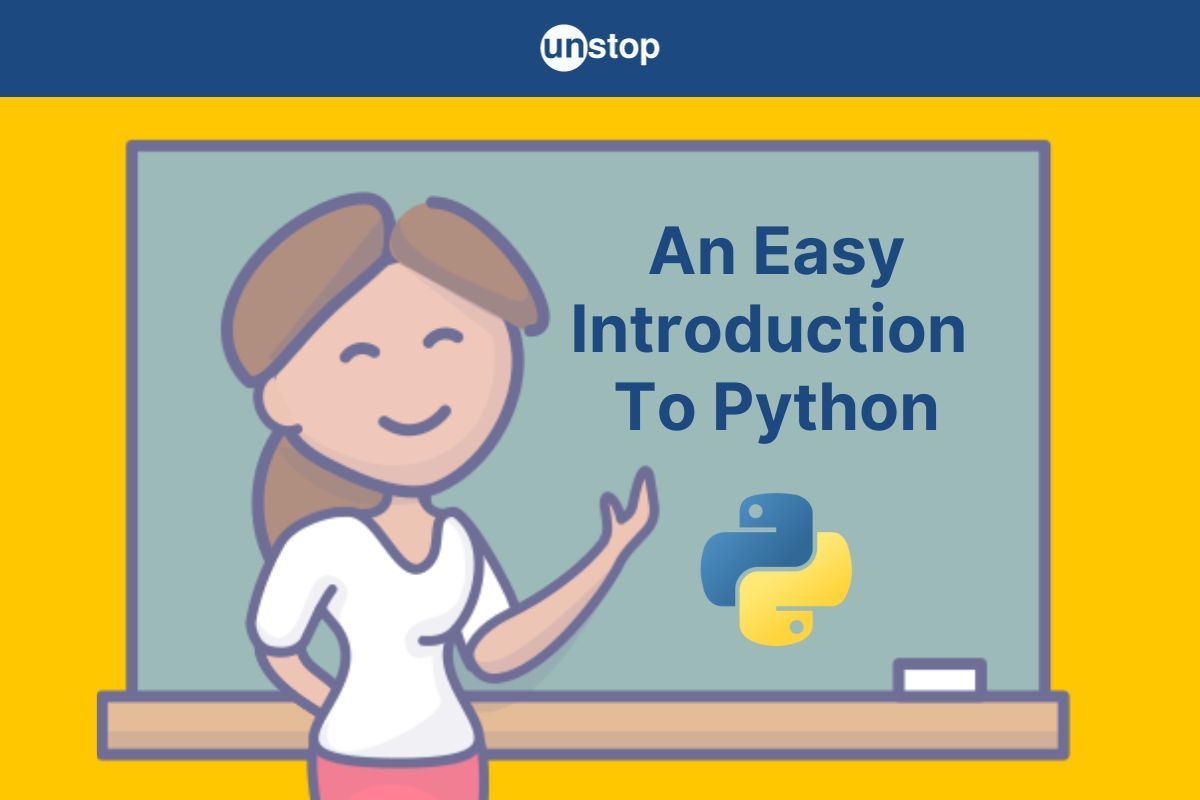
Wondering what is Python? Wait, we aren't talking about the slithering serpent that comes to the mind of most people when they hear this word. We are talking about the high-level, object-oriented, general-purpose programming language that has taken the tech world by storm. Renowned for its readability and expressiveness, Python beckons developers into a world where code becomes a language of its own- a language not just comprehensible to machines but also to those who craft it.
In this article, we will embark on a journey through the multiple facets of what Python truly is and how it became the darling of the programming world. We will begin by exploring the history of Python to trace its origin, uncover its complexities, shine a light on its remarkable merits, and candidly discuss its limitations in comparison to its programming peers.
We will also traverse the paths of Python 2 and Python 3 and unearth the distinctive features of these versions, along with other noteworthy iterations. By the time we conclude, you will fully understand what is Python and will be empowered to wield its magic in your own coding endeavors.
What Is Python? An Introduction
In the dynamic realm of programming languages, Python stands as a towering figure, weaving a rich tapestry of simplicity, versatility, and innovation. Conceived in the late 1980s by the ingenious Guido van Rossum, Python has evolved into a programming language that transcends boundaries and resonates across diverse sectors of the technological landscape.
- Python is an object-oriented, high-level, interpreted programming language with dynamic semantics.
- It is suitable for Rapid Application Development as well as for usage as a scripting or glue language to link already existing components because of its high-level built-in data structures, dynamic typing, and dynamic binding.
- Python's basic, English-like syntax places a strong focus on readability and has an easy learning curve. This also lowers the cost of program maintenance for users.
- Python's support for modules and packages promotes the modularity and reuse of code in programs.
- The comprehensive standard library and the Python interpreter are freely distributable and are offered in source or binary form for all commonly used platforms.
In recent years, it has grown to be among the most widely used, popular, and versatile programming languages. Large software components are being successfully assembled using Python, an advanced scripting language. Additionally, Python is used in several professions beyond the IT sector.
What Is The History Of Python?
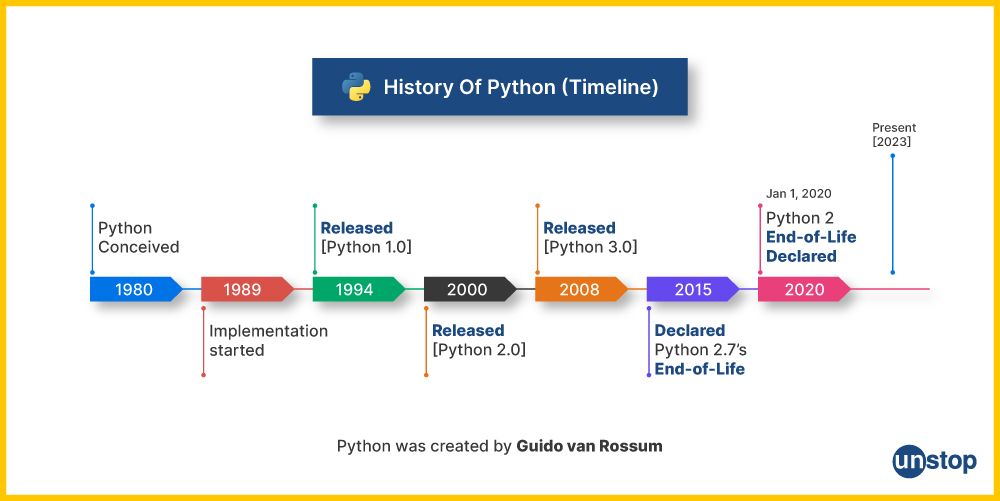
The history of the Python programming language is marked by its evolution from a pet project to a powerhouse in the world of software development. It is not just a chronicle of versions and releases. It is a testament to the collaborative spirit of its community, the adaptability of its design, and its enduring commitment to simplicity and readability. Here's a brief overview of its key milestones-
-
Genesis (Late 1980s): Python's story begins in the late 1980s when Guido van Rossum, a Dutch programmer, started working on a hobby project during the Christmas holidays. His goal was to create a language that emphasized code readability and allowed for the creation of both small and large-scale software projects.
-
Python 0.9.0 (February 1991): The first official release of Python, version 0.9.0, came in February 1991. This release already included features that have remained integral to Python, such as exception handling, functions, and modules.
-
Python 1.0 (January 1994): The beginning of 1994 brought the release of Python 1.0 and marked the language's maturation. The January issue included features like lambda, map, filter, and reduce, reflecting a growing emphasis on functional programming constructs.
-
Python 2.0 (October 2000): The next milestone for this language was the release of Python 2.0 in October 2000. This version introduced list comprehensions, garbage collection, and Unicode support. And also solidified Python's position as a powerful and efficient language for various applications.
-
The PEP Process (2000 Onwards): Guido van Rossum introduced the Python Enhancement Proposal (PEP) process in 2000 to manage and propose new features for the language. This transparent and community-driven approach allowed developers to actively participate in shaping the language's future.
-
Python 3.0 (December 2008): Also known as Python 3000 or Py3k for short, the release of Python 3.0 represents one of the most significant milestones in its history. It aimed to rectify design flaws and improve the language's consistency. While backward incompatible, Python 3 laid the foundation for a more robust and modern language.
-
Community Growth and Ecosystem (2010s): Throughout the 2010s, Python's community and ecosystem expanded rapidly. The growth was fueled by the rise of web development frameworks like Django and Flask, data science libraries such as NumPy and Pandas, and the language's suitability for machine learning and artificial intelligence.
-
Guido van Rossum's Retirement (July 2018): In July 2018, Guido van Rossum, the Benevolent Dictator For Life (BDFL) of Python, stepped down from his leadership role. This marked a shift in the governance model, with the Python Steering Council taking over the decision-making process.
-
Python 2 End of Life (January 2020): Python 2 reached the end of its life on January 1, 2020. With this, the Python community's focus shifted entirely to Python 3, encouraging users to migrate their codebases to the latest version.
-
Python 3.9 (October 2020): Python 3.9 continued the tradition of introducing new features and optimizations. It showcased Python's commitment to staying at the forefront of technology while maintaining stability and backward compatibility.
- Continued Relevance and Future (2020s Onwards): Python's popularity continues to soar in the 2020s, with its applications expanding into areas such as data science, machine learning, and artificial intelligence. The language's readability, extensive library support, and vibrant community position it as a linchpin in contemporary software development.
Key Features Of The Python Programming Language 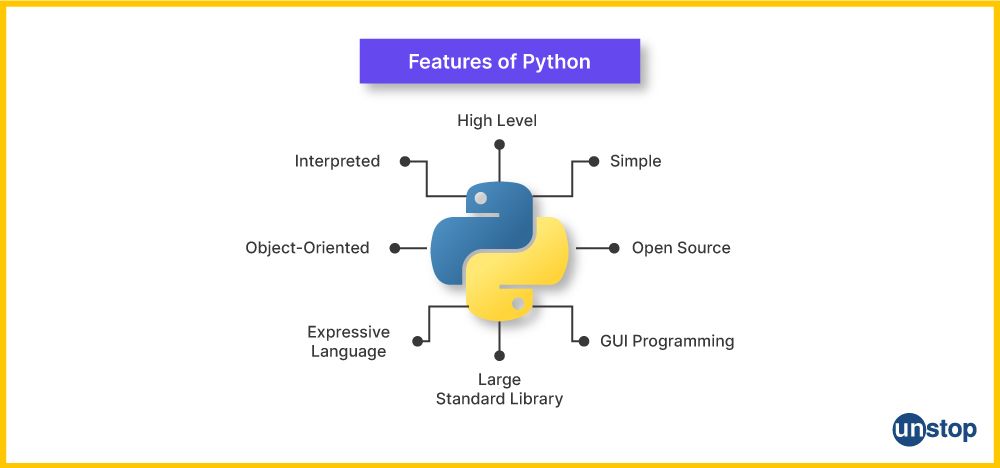
As we’ve mentioned before, Python is a high-level, object-oriented, and dynamically typed language. While it is known for its simplicity and readability, some other important features of the language are:
- Interpreted Language: This implies that Python code is executed one line at a time, making it an interpreted language. Also, in comparison to other popular languages like C, C++, Java, etc., Python code does not require compilation, making it easier to debug. In fact, an immediate format called the Bytecode is created from Python's source code.
- Cross-platform Language: Python is compatible with many operating systems/ platforms, including Windows, macOS, Linux, etc. This feature allows Python code to be portable across platforms, further allowing programmers to write code once and run it indistinguishably on several platforms.
- Free and Open Source: The language is free to download and use. Users can download Python from the official website. In addition to that, the public can also see the source code since Python is open-source.
- Object Oriented: Python has object-oriented programming features, enabling the creation and use of classes, objects, and inheritance. It encourages modular and reusable code, making it easier to develop complex applications.
- Broad Standard Library: Python contains a huge standard library with a wide selection of modules and functions, so you don't need to write any of your own code. Regular expressions, unit testing, web browsers, and other tools are all part of Python's sizable library.
- GUI Support: It is possible to create/ develop graphical user interfaces in Python by using packages like PyQt5, PyQt4, wxPython, or Tk.
- Easy to Use and Maintain: Python is pretty easy to pick up compared to other languages like C, C#, Javascript, etc. Anyone can pick up the basics of the relatively easy programming language in even a few hours or days. These features have won Python the title of one of the most user-friendly programming languages out there.
- Robust: The robustness of Python is owed to its formidable error-management capabilities, which let programmers find and fix errors in their code effectively. These features include integrated exception handling and traceback information.
- Dynamically Typed: Python is a dynamically typed language, i.e., the variable type is decided at run time (for example, int, double, long, etc.). This feature eliminates the need for users to declare the type of a variable.
These features contribute to making Python the popular choice for beginners, experienced developers, and scientists alike. Thus making it a versatile language for a wide range of applications.
Who Uses Python?
Candidates with a strong understanding of Python are sought after by a broad range of financial institutions, IT firms, government organizations, and more for positions in data science, web development, and other related fields. In general, Python developers (also known as Web developers or, more accurately, Back-End developers) use Python to create a variety of things, including websites, programs, games, and more. Let's take a look at different sectors that use Python today:
- Big Tech Companies: Several large corporations, including Intel, IBM, NASA, Pixar, Netflix, Facebook, JP Morgan Chase, Spotify, etc., use Python. In fact, the language is one of Google's four primary programming languages and is also extensively used on YouTube. The same is true of Instagram, Pinterest, and Reddit.
-
Startups: Many startups choose Python for its rapid development capabilities and the ability to scale as their projects grow. The language's extensive ecosystem and community support are advantageous for startups with limited resources.
- Developers: Python was also used to create the initial BitTorrent client. Additionally, it serves as a scripting language for Maya, the predominant 3D modeling and animation program. Django and Flask, two popular web development frameworks, are also built using Python. Many web applications, including Instagram and Pinterest, leverage Python for their backend development.
- Engineers: Because Python's libraries are so simple to use, production engineers at Facebook are freed up to concentrate on getting updates live rather than writing and maintaining a lot of code. Additionally, it guarantees effective infrastructure scaling for Facebook. Uber, Goldman Sachs, PayPal, Netflix, and Google are a few well-known companies that need developers, engineers, and data specialists who are proficient in Python.
-
Finance: In the finance industry, Python is employed for quantitative analysis, risk management, and algorithmic trading. Financial institutions and hedge funds use Python for its flexibility and extensive library support.
- Non-IT Sectors: Python is used across sectors and is not just sought after in certain industries. This language is used extensively in a variety of domains, including astronomy, social science, artificial intelligence (AI), and the Internet of Things (IoT).
- Students and Beginners: Students can easily comprehend Python thanks to its clear/ simple syntax and readability, which allows them to concentrate on grasping important programming principles. Python encourages young people's creativity and curiosity since it is a flexible language that can be used in a variety of industries, including game creation, data analysis, and web development.
Basic Characteristics Of Python Programming Syntax
Python syntax refers to the set of rules that dictate how Python code should be written to ensure it is both syntactically correct and logically meaningful. Here are key aspects of Python syntax:
Indentation In Python Syntax
When writing programs, we quite often have to provide blocks of code to indicate elements such as functions, loops, conditional statements, etc. But how? Well, in Python, we use indentation to mark blocks of code. In other words, consistent indentation is essential for defining the code structure.
Unlike many other programming languages that use braces or keywords, Python relies on the level of indentation to determine the scope of code blocks. We make use of a number of leading whitespace (either tabs or spaces, not both) to establish the line's indentation level. By default, a single indent level in Python is four spaces (or one tab). For example-
if x > 0:
print("Positive number")
else:
print("Non-positive number")
Whitespace
Python is whitespace-sensitive, and the amount of indentation matters. Consistency in indentation is crucial for the correct interpretation of code blocks. Mixing tabs and spaces or inconsistent indentation can lead to syntax errors.
# Good indentation
if x > 0:
print("Positive number")# Incorrect indentation (may cause an error)
if x > 0:
print("Positive number")
In the first block, we have four spaces (i.e., one tab) to indent the if-statement, which is the correct way to indent. In the second block though, we have used one tab and a whitespace, leading to incorrect indentation.
Colon (:) For Code Blocks
We use a colon in Python syntax to denote the beginning of a code block, such as in the case of loops, conditionals, and function definitions. The indented lines that follow the colon form the body of the block. For example-
for i in range(5):
print(i)
Comments In Python
Coders, programmers, or software developers writing codes in Python can leave remarks (description or annotation) for fellow programmers, just like in any other programming language. However, in contrast, comments in Python start with the hashtag symbol (#) and are used to provide explanations or documentation within code.
They are included to make the source code more human-readable, while the Python interpreter ignores them. Python allows both single-line (or end-of-line) and multi-line (block) comments. For example-
# This is a single-line comment
"""
This is a
multi-line comment
"""
Variables & Assignment
In Python, variables are created simply by assigning values to the names of variables using the assignment operator (=). Since it is dynamically typed, the variable types are inferred at runtime. For example-
x = 10
name = "Shivani"
Data Types
Python supports various data types, including integers, floats, strings, lists, tuples, dictionaries, and more. The syntax for creating and manipulating these data types is integral to Python programming. Note that since
# List creation
numbers = [1, 2, 3, 4, 5]# String concatenation
greeting = "Hello, " + name
Functions
In Python, functions are defined using the def keyword, followed by the function name and parameters. Also, the function body/ lines of code must have a consistent indentation. For example-
def add_numbers(a, b):
return a + b
Conditional Statements
Python uses if, elif (else if), and else for conditional statements. The indentation determines the blocks of code associated with each condition. For example-
if x > 0:
print("Positive number")
elif x == 0:
print("Zero")
else:
print("Negative number")
Loops
Python supports for and while loops. The for loop is often used for iterating over sequences, while the while loop is used for repeated execution based on a condition. For example-
# For loop
for i in range(5):
print(i)# While loop
while x > 0:
print(x)
x -= 1
Code Sample:
CODE SNIPPET IS HEREZGVmIGNhbGN1bGF0ZV9zdW0obnVtYmVycyk6DQogICAgIyBJbml0aWFsaXplIGEgdmFyaWFibGUgdG8gc3RvcmUgdGhlIHN1bQ0KICAgIHRvdGFsX3N1bSA9IHN1bShudW1iZXJzKSANCiAgICAjIFJldHVybiB0aGUgY2FsY3VsYXRlZCBzdW0NCiAgICByZXR1cm4gdG90YWxfc3VtDQoNCiMgRXhhbXBsZSBsaXN0IG9mIG51bWJlcnMNCm51bWJlcnNfbGlzdCA9IFsxLCAyLCAzLCA0LCA1XQ0KDQojIENhbGwgdGhlIGZ1bmN0aW9uIGFuZCBzdG9yZSB0aGUgcmVzdWx0DQpyZXN1bHRfc3VtID0gY2FsY3VsYXRlX3N1bShudW1iZXJzX2xpc3QpDQoNCiMgUHJpbnQgdGhlIHJlc3VsdA0KcHJpbnQoIlN1bSBvZiBudW1iZXJzOiIsIHJlc3VsdF9zdW0p
Output:
Sum of numbers: 15
Explanation:
In the Python code above,
- The calculate_sum function is defined using the def keyword.
- It takes a list of numbers as a parameter. Inside the function, a variable total_sum is initialized to 0. This variable will be used to store the sum of the numbers.
- A for loop is used to iterate through each number in the given list (numbers). The indentation indicates the block of code belonging to the loop.
- Within the loop, each number is added to the total_sum variable. This process repeats for each element in the list.
- After the loop completes, the function returns the calculated sum (total_sum). An example list of numbers (numbers_list = [1, 2, 3, 4, 5]) is created.
- The calculate_sum function is called with this list as an argument, and the result is stored in the variable result_sum.
- The result is printed using the print statement, showing the sum of the numbers in the list.
Python Syntax Vs. Other Programming Languages
Python's syntax differs from many other programming languages in several ways, emphasizing readability, simplicity, and expressiveness. Here are some key differences in Python syntax compared to other languages:
| Feature | Python | Other Languages (e.g., Java, C++) |
|---|---|---|
| Whitespace Significance | Indentation determines code blocks | Braces {} or keywords (begin, end) determine blocks/ bundles of code |
| Explicit Variable Declaration | No explicit declaration is required | Requires explicit type and declaration of variables |
| Dynamic Typing | Dynamically typed | Statically typed |
| Colon and Indentation | Colon (:) and indentation define blocks | Braces {} or keywords () |
| Simplicity and Expressiveness | Emphasis on simplicity and expressiveness | Syntax may be more verbose |
| Duck Typing | Follows duck typing philosophy | Explicit type declarations often required |
| Semicolons for Line Termination | Not required (newline terminates statements) | Required to terminate statements on the same line |
| Extensive Standard Library | Comprehensive standard library | Standard libraries may vary in coverage |
The syntax of languages such as Node.js, Java, and C++ is intricate and requires the user to adhere to particular programming conventions, such as the usage of curly brackets and semicolons at the conclusion of statements. Python, in contrast, lacks such programming conventions. The indentation rules used by Python, are comparable to those of the English language, making it simpler for programmers to grasp.
Why Should You Learn Python?
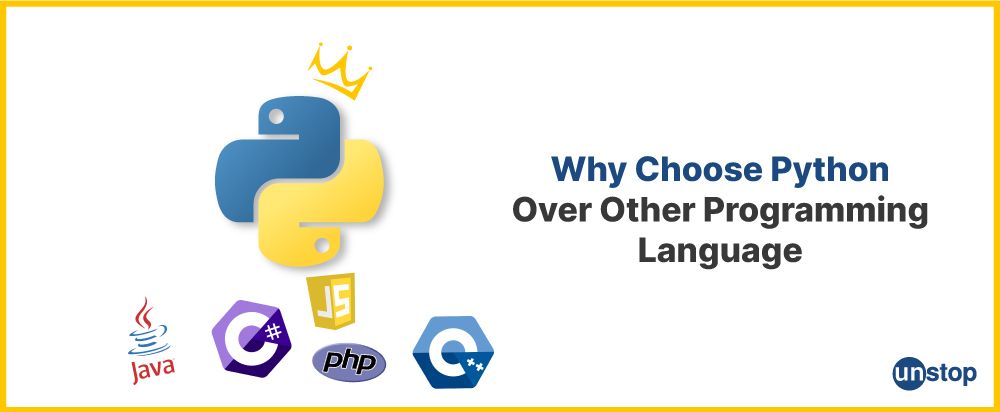
There is no denying the fact that Python is one of the most popular programming languages. Learning this high-level language is an advantageous endeavor for several reasons, including-
- Python's readability and simplicity make it an ideal language for beginners, reducing the learning curve and fostering a smooth entry into the world of programming.
- Its versatility shines through in various domains, from web development using frameworks like Django and Flask to data science and machine learning with libraries such as NumPy and TensorFlow.
- The extensive support from a vibrant and strong community of developers as well as enthusiasts ensures that learners have access to a wealth of resources and assistance.
- Python's widespread use in artificial intelligence, automation, and emerging technologies makes it one of the most valuable and in-demand skills in the job market.
- Its cross-platform compatibility, rapid prototyping capabilities, and educational value further solidify Python as a top choice for both newcomers and seasoned developers seeking a powerful, accessible, and community-driven programming language.
Applications Of Python Language
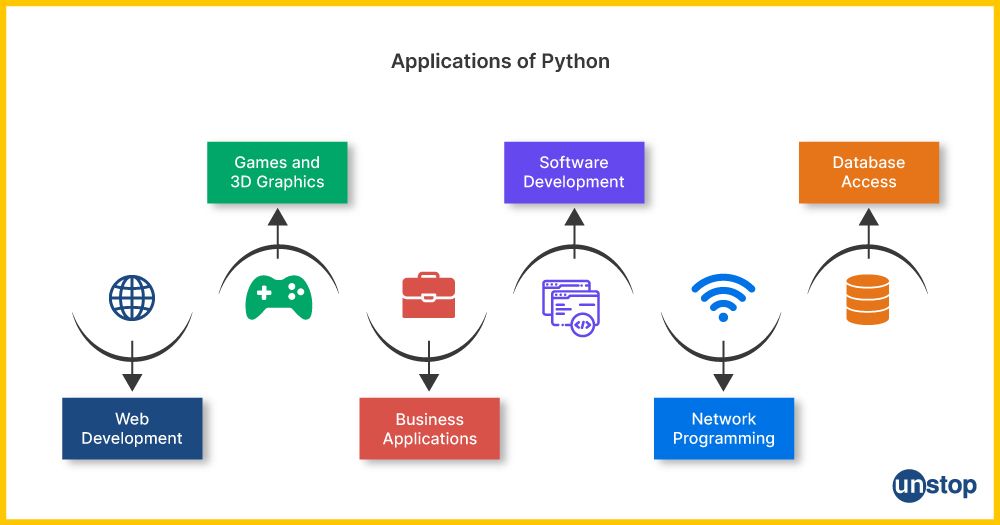
Python's flexibility is a key benefit and one of the reasons for its extensive use across a variety of industries. There are over 125,000 third-party Python libraries available for users, which significantly increase the capability and potential of the language. Listed below are the key domains and areas where Python is commonly employed.
- Web Development: Python is widely used for web development and application creation, with frameworks such as Django, Flask, and Pyramid. These frameworks simplify the development of scalable and maintainable web applications.
- Data Science and Machine Learning: Python has become a dominant language in the field of data science and machine learning. Libraries like NumPy, Pandas, Scikit-learn, TensorFlow, and PyTorch provide powerful tools for data analysis, modeling, and deep learning.
- Artificial Intelligence and Natural Language Processing (NLP): Python is extensively used in AI and NLP applications. Libraries like NLTK and spaCy are popular for natural language processing tasks, while frameworks like OpenCV and scikit-image are used in computer vision applications.
- Scientific Computing: Python is a preferred language in scientific research, computing, and a multitude of other science tasks. Its libraries, such as SciPy and Matplotlib, facilitate complex computations, simulations, and data visualization.
- Automation and Scripting: The simplicity and readability of this general-purpose language make it an excellent choice for automation and scripting. Python scripts are widely used to simplify the process in many operations ranging from automation to system administration.
- Backend Development: Python is commonly used for backend development and powering server-side web development/ logic in various applications. Web application frameworks like Django and Flask facilitate the creation of robust and scalable backend systems. These frameworks provide pre-built components, reliable routing systems, and database integration, thus making web development simpler.
- Game Development: Python is used in game development (for 3D games to more complex video games), both for scripting within game engines and for developing game logic. A notable example of this is Pygame, a set of Python modules designed for writing video games.
- Desktop GUI Applications: Python can be used for developing desktop applications with graphical user interfaces (GUI). Libraries like Tkinter, PyQt, and Kivy enable the creation of cross-platform desktop application GUIs.
- Network Programming: Python is well-suited for network programming, with libraries such as Twisted facilitating the development of networking applications, servers, and protocols.
- Cybersecurity and Penetration Testing: Python is widely used in the field of cybersecurity and penetration testing. Its simplicity, combined with libraries like Scapy and PyCrypto, makes it an excellent choice for security professionals.
- Internet of Things (IoT): Python's simplicity and versatility make it a popular choice for IoT development. MicroPython, a Python 3 implementation optimized for microcontrollers, is specifically designed for embedded systems.
- Education: Python is commonly used as the first programming language in educational settings. Its readability and straightforward syntax make it an ideal choice for teaching programming concepts.
- Finance and Quantitative Analysis: Python is widely adopted in the finance industry for quantitative analysis, risk management, and algorithmic trading. Some of the most commonly used libraries for financial modeling are NumPy and Pandas.
- Content Management Systems (CMS): Python is used for developing content management systems, and frameworks like Wagtail provide a robust platform for building content-driven websites.
Advantages And Disadvantages Of Python
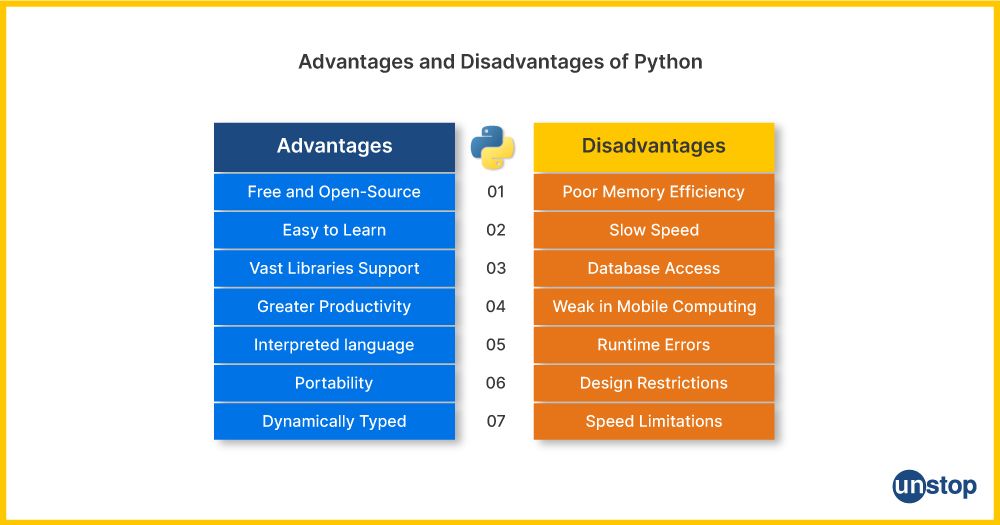
When learning a new language like Python, you should be aware of both its advantages and disadvantages. This will provide you with a better understanding of how to use the Python programming language to its full potential. Let's start with Python's benefits and drawbacks.
Advantages Of Python
- Readability and Simplicity: Python's syntax is clear, readable, and concise, making it an excellent language for beginners and experienced developers alike. The emphasis on code readability encourages maintainability and reduces the cost of program maintenance.
- Extensive Standard Library: Python comes with a vast standard library that includes modules and packages for a wide range of tasks, from web development and data analysis to artificial intelligence and networking. This feature eliminates the need to write code from scratch for many common tasks.
- Community and Support: Python has a large and active community of developers. This community contributes to the language's growth and provides support through forums and online communities, thus continually expanding the vast ecosystem of libraries and frameworks.
- Versatility: Python is a versatile language that supports multiple programming paradigms, including procedural, object-oriented, and functional programming. Its adaptability makes it suitable for a broad spectrum of applications.
- Interpreted and Interactive: Python is an interpreted language, allowing for quick development and testing. It also supports an interactive mode, where code can be executed line by line, making it an ideal language for prototyping and learning.
- Platform Independence: Python is a cross-platform language, meaning that code written on one platform can run on multiple platforms without modification. This feature simplifies the development process and enhances code portability.
- Integration Capabilities: Python can easily integrate with other languages and technologies, making it a popular choice for building applications that involve diverse components. It has robust support for integration with C, C++, and Java.
- Dynamically Typed: Python is a dynamically typed language, meaning that variable types are interpreted at runtime. This flexibility allows for faster development and makes the language more forgiving.
Disadvantages Of Python
- Execution Speed: While Python is known for its simplicity and readability, it may not be as fast as languages like C or C++. This can be a drawback in situations where high performance is critical, such as certain computational tasks or real-time applications.
- Global Interpreter Lock (GIL): Python's Global Interpreter Lock can be a limitation in multithreaded applications, as it restricts the execution of multiple threads at the same time. This can impact the performance of CPU-bound and multithreaded applications.
- Mobile Development: Python is not the first choice for mobile app development, especially for resource-intensive applications. While frameworks like Kivy and BeeWare exist, they may not offer the same level of support and performance as native mobile development languages.
- Database Access: Python's database access layers are not as mature as those in some other languages. While there are libraries like SQLAlchemy, some developers argue that database support could be more robust.
- Design Restrictions: Python's design philosophy may not align with certain projects or coding styles. For example, the emphasis on indentation and whitespace can be a point of contention for developers accustomed to other formatting practices.
- Limited to GIL in CPython: The Global Interpreter Lock (GIL) in CPython limits the execution of multiple threads. Although this design choice simplifies memory management, it can hinder the performance of multi-core processors in certain scenarios.
Also read- 20+ Best Python Projects Ideas
Some Useful Python Tips & Tricks For Efficient Programming
When writing code from scratch, a developer's life can be greatly simplified by Python's minimalism. However, there are several lesser-known Python techniques that may sway you with their incredible power. In this section, we’ll discuss useful tricks that can help you write short, meaningful codes in Python.
1. Value Swapping: In Python, you can change the values of two variables without using a temporary variable with a straightforward one-liner.
Code:
CODE SNIPPET IS HEREYSA9IDUKYiA9IDEwCmEsIGIgPSBiLCBhCnByaW50KGEsIGIp
Output:
10 5
Explanation:
In the example above, the one-liner (a, b = b, a) swaps the values of a and b. The values are then assigned to a and b on the right-hand side, which first produces a tuple (b, a) before unpacking it. The values of a and b are consequently switched.
2. Reversing a String: You can reverse a string in Python using slicing with a step of (-1).
Code:
CODE SNIPPET IS HEREb3JpZ2luYWxfc3RyaW5nID0gIkhlbGxvLCBXb3JsZCEiCnJldmVyc2VkX3N0cmluZyA9IG9yaWdpbmFsX3N0cmluZ1s6Oi0xXQpwcmludChyZXZlcnNlZF9zdHJpbmcp
Output:
"!dlroW ,olleH"
Explanation:
Here, the string is reversed using the [::-1] slicing operation. It reverses the letters' order by beginning at the end of the string and moving backward by -1.
3. List Comprehensions: List comprehensions allow you to create concise lists based on existing lists or other iterable objects.
Code:
CODE SNIPPET IS HEREc3F1YXJlcyA9IFt4KioyIGZvciB4IGluIHJhbmdlKDEsIDYpXQpwcmludChzcXVhcmVzKQ==
Output:
[1, 4, 9, 16, 25]
Explanation:
Here, a new list is created by square rooting each number in the range of 1 to 5 using the list comprehension [x**2 for x in range(1, 6)].
4. Unpacking Elements: In Python, it's simple to split out the elements of a list or tuple into independent variables.
Code:
CODE SNIPPET IS HEREYSwgYiwgYyA9IFsxLCAyLCAzXQpwcmludChhLCBiLCBjKQ==
Output:
1 2 3
Explanation:
Here, the elements of the list [1, 2, 3] are unpacked into individual variables a, b, and c. And each variable is assigned the corresponding value from the list.
5. Enumerate: You may loop through an iterative using the enumerate() method in Python, to get the index and value of each element.
Code:
CODE SNIPPET IS HEREbXlfbGlzdCA9IFsnYScsICdiJywgJ2MnXQpmb3IgaW5kZXgsIHZhbHVlIGluIGVudW1lcmF0ZShteV9saXN0KToKwqAgwqAgcHJpbnQoaW5kZXgsIHZhbHVlKQ==
Output:
0 a
1 b
2 c
Explanation:
In the example above, we iterate over my_list using the enumerate() method, which returns the index and value of each item. While the index variable keeps the element's index, the value variable preserves the pertinent value.
6. Zip: The zip() function in Python combines multiple iterables into a single iterable of tuples, grouping corresponding elements together.
Code:
CODE SNIPPET IS HEREbGlzdDEgPSBbMSwgMiwgM10KbGlzdDIgPSBbJ2EnLCAnYicsICdjJ10KY29tYmluZWQgPSB6aXAobGlzdDEsIGxpc3QyKQpwcmludChsaXN0KGNvbWJpbmVkKSk=
Output:
[(1, 'a'), (2, 'b'), (3, 'c')]
Explanation:
In the Python program here, the zip() function's List1 and List2 elements are concatenated into tuples. The corresponding items are matched up in the resultant tuples. You can see the tuples as the result by converting the zip object to a list.
Python 2 Vs. Python 3: Which Should You Learn?
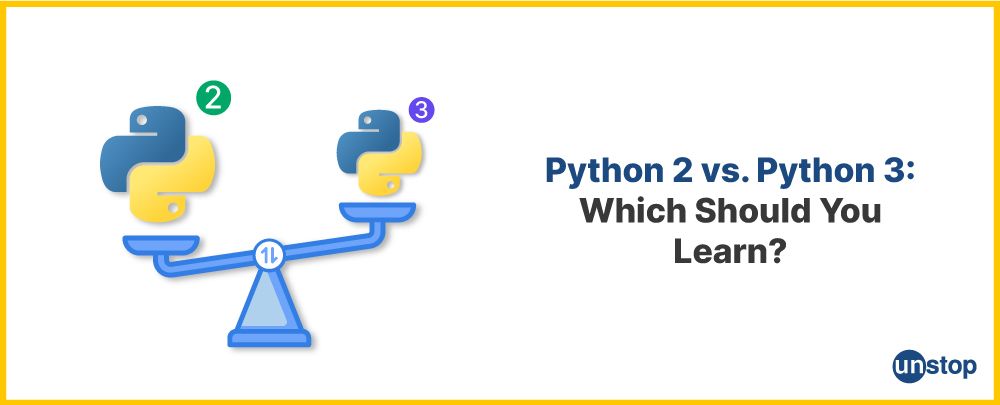
The obvious choice for any developer who is starting to learn how to program in Python is Python 3. The language has undergone modifications that make it simpler to produce high-quality code. This is the primary motivation behind the version's creation. The Python community merely needed some time to catch up and update all the third-party libraries that programmers relied on to complete their work.
Most of these third-party libraries were not updated to Python 3 for quite a few years. However, compared to the earlier version, Python 3 is now supported by a wider range of libraries. Additionally, Python 2 is no longer being developed as of the start of 2020. The last version of Python 2 had been in maintenance mode for years by then, and all its new features were added to Python 3. For the most part, you won’t find much Python 2 code in use today.
Now, let us take a look at some key differences between these two languages.
|
Python 2 |
Python 3 |
|
It is the more stable and transparent version of the Python programming language. |
It is the future of Python, created to address the design flaws in the previous versions. |
|
The print syntax is treated as a statement rather than a function, which requires text to be wrapped in parenthesis. E.g., print "Hello" |
The print is explicitly treated as a function and replaced by the print() function in Python 3, which requires an extra pair of parenthesis. E.g., print("Hello") |
|
ASCII string type is used by default to store strings. |
Unicode is the implicit string type by default. |
|
It simply returns an integer to the nearest whole number when dividing two integers. |
It makes integer division more intuitive by using true division for integers and floats |
|
Xrange function reconstructs the sequence every time. |
Xrange is replaced by the range() function in Python 3. |
Python Libraries
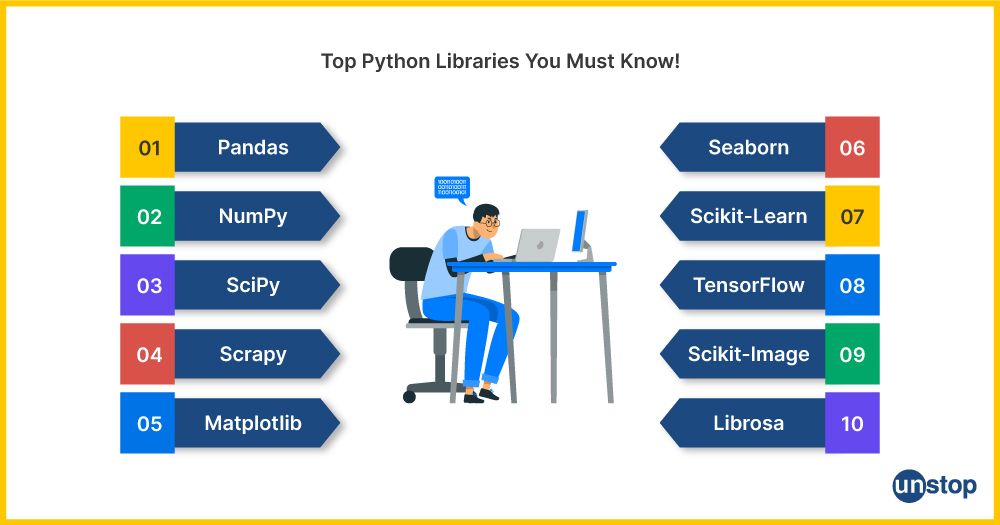
The Python libraries refer to a group of connected modules that further have collections of code that may be reused in many programs. For the programmer, it simplifies and makes Python programming more practical to use. This is because, with the use of libraries, we don't have to develop the same code for many programs repeatedly. Python libraries are particularly important when working in domains like machine learning, data science, data visualization, etc.
Here’s a list of the most commonly used Python libraries:
1. NumPy:
Purpose: It is used for numerical computing.
Description: NumPy is a fundamental library for numerical operations in Python. It provides support for large, multi-dimensional arrays and matrices, along with mathematical functions to operate on these arrays.
Example:
CODE SNIPPET IS HEREaW1wb3J0IG51bXB5IGFzIG5wCgojIEV4YW1wbGU6IENyZWF0aW5nIGEgTnVtUHkgYXJyYXkKYXJyID0gbnAuYXJyYXkoWzEsIDIsIDMsIDQsIDVdKQ==
2. Pandas:
Purpose: It is mainly used for data manipulation and analysis.
Description: Pandas is a powerful library for data manipulation and analysis. It introduces data structures like DataFrames and Series, making it easy to clean, transform, and analyze structured data.
Example:
CODE SNIPPET IS HEREaW1wb3J0IHBhbmRhcyBhcyBwZAoKIyBFeGFtcGxlOiBDcmVhdGluZyBhIFBhbmRhcyBEYXRhRnJhbWUKZGF0YSA9IHsnTmFtZSc6IFsnU2hyZWV5YScsICdTaGl2YW5pJywgJ1NyaXNodGknXSwgJ0FnZSc6IFsyNSwgMzAsIDM1XX0KZGYgPSBwZC5EYXRhRnJhbWUoZGF0YSk=
3. Matplotlib:
Purpose: It is used in the area of data visualization.
Description: Matplotlib is a versatile library for creating static, animated, and interactive visualizations in Python. It provides a wide range of plotting functions for various types of charts (like bar charts, pie charts, etc.).
Example:
CODE SNIPPET IS HEREaW1wb3J0IG1hdHBsb3RsaWIucHlwbG90IGFzIHBsdAoKIyBFeGFtcGxlOiBDcmVhdGluZyBhIHNpbXBsZSBwbG90CnggPSBbMSwgMiwgMywgNCwgNV0KeSA9IFsyLCA0LCA2LCA4LCAxMF0KcGx0LnBsb3QoeCwgeSkKcGx0LnhsYWJlbCgnWC1heGlzJykKcGx0LnlsYWJlbCgnWS1heGlzJykKcGx0LnNob3coKQ==
4. Scikit-learn:
Purpose: It is primarily used in the field of machine learning.
Description: Scikit-learn is a machine-learning library that provides simple and efficient tools for data mining and data analysis. It includes various algorithms for classification, regression, clustering, and more.
Note: To run the code provided below, you need to install the scikit-learn module using a package manager like pip. Open a terminal or command prompt and run the following command:
pip install scikit-learn
This will install the scikit-learn library, and you should be able to run your code after the installation is complete.
Example:
CODE SNIPPET IS HEREZnJvbSBza2xlYXJuIGltcG9ydCBkYXRhc2V0cwpmcm9tIHNrbGVhcm4ubW9kZWxfc2VsZWN0aW9uIGltcG9ydCB0cmFpbl90ZXN0X3NwbGl0CmZyb20gc2tsZWFybi5uZWlnaGJvcnMgaW1wb3J0IEtOZWlnaGJvcnNDbGFzc2lmaWVyCgojIEV4YW1wbGU6IFVzaW5nIEstbmVhcmVzdCBuZWlnaGJvcnMgZm9yIGNsYXNzaWZpY2F0aW9uCmlyaXMgPSBkYXRhc2V0cy5sb2FkX2lyaXMoKQpYX3RyYWluLCBYX3Rlc3QsIHlfdHJhaW4sIHlfdGVzdCA9IHRyYWluX3Rlc3Rfc3BsaXQoaXJpcy5kYXRhLCBpcmlzLnRhcmdldCwgdGVzdF9zaXplPTAuMikKa25uID0gS05laWdoYm9yc0NsYXNzaWZpZXIobl9uZWlnaGJvcnM9MykKa25uLmZpdChYX3RyYWluLCB5X3RyYWluKQ==
5. TensorFlow and PyTorch:
Purpose: It is used in deep learning and related domains.
Description: TensorFlow and PyTorch are leading libraries for developing and training deep neural networks. They provide a flexible platform for building complex neural network architectures and are widely used in research and industry.
Note: To run the code provided below, you need to install the TensorFlow module using pip. Open a terminal or command prompt and run the following command:
pip install tensorflow
This will install the TensorFlow library, and you should be able to run your code after the installation is complete.
Note: To run the code provided below, you need to install the Flask module using pip. Open a terminal or command prompt and run the following command:
pip install flask
This will install the Flask library, and you should be able to run your Flask application after the installation is complete.
Example:
CODE SNIPPET IS HEREaW1wb3J0IHRlbnNvcmZsb3cgYXMgdGYKaW1wb3J0IHRvcmNoCgojIEV4YW1wbGU6IENyZWF0aW5nIGEgc2ltcGxlIG5ldXJhbCBuZXR3b3JrIHdpdGggVGVuc29yRmxvdwptb2RlbCA9IHRmLmtlcmFzLlNlcXVlbnRpYWwoWwp0Zi5rZXJhcy5sYXllcnMuRGVuc2UoMTI4LCBhY3RpdmF0aW9uPSdyZWx1JyksCnRmLmtlcmFzLmxheWVycy5Ecm9wb3V0KDAuMiksCnRmLmtlcmFzLmxheWVycy5EZW5zZSgxMCkKXSk=
6. Flask and Django:
Purpose: It is used widely in web development.
Description: Flask and Django are popular web development frameworks. Flask is a lightweight micro-framework, while Django is a more comprehensive framework with built-in features like an ORM, admin interface, and authentication.
Example:
CODE SNIPPET IS HEREZnJvbSBmbGFzayBpbXBvcnQgRmxhc2sKCiMgRXhhbXBsZTogQ3JlYXRpbmcgYSBzaW1wbGUgRmxhc2sgYXBwCmFwcCA9IEZsYXNrKF9fbmFtZV9fKQoKQGFwcC5yb3V0ZSgnLycpCmRlZiBoZWxsb193b3JsZCgpOgpyZXR1cm4gJ0hlbGxvLCBXb3JsZCEnCgppZiBfX25hbWVfXyA9PSAnX19tYWluX18nOgphcHAucnVuKCk=
Conclusion
In conclusion, Python's widespread adoption can be attributed to its simplicity, readability, versatility, and a thriving community. It provides a solid foundation for a wide range of applications, irrespective of whether you're a beginner learning to code or an experienced developer working on complex projects. Python has proven to be a language that has not only stood the test of time but has also emerged as a linchpin in the ever-evolving realms of web development, data science, artificial intelligence, machine learning, and beyond.
As technology continues to evolve, Python is likely to remain a dominant force in the programming world, supporting innovation across various domains. For careers in software development, engineering, DevOps, machine learning, data analytics, web development, and testing, Python is a fantastic choice.
Frequently Asked Questions
Q. What is Python used for?
Python is frequently used for creating websites, operating systems, and applications, automating repetitive tasks, and analyzing and displaying data. Python has been used by many non-programmers, including accountants and scientists, for a range of routine activities like managing finances. This is primarily because Python is simple to learn and closely resembles human language.
Q. What is Python, with an example?
Python is a computer programming language that is frequently used to create software and websites, automate processes, and do data analysis. Because Python is a general-purpose programming language, it can be used to develop a wide range of programs and isn't tailored for any particular task. It has become one of the go-to languages for many thanks to its versatility and beginner-friendliness. It is also a dynamically typed and garbage-collected programming language.
Here is an example of a Python code snippet-
CODE SNIPPET IS HEREIyBDYWxjdWxhdGUgdGhlIGFyZWEgb2YgYSByZWN0YW5nbGUKbGVuZ3RoID0gNQp3aWR0aCA9IDMKYXJlYSA9IGxlbmd0aCAqIHdpZHRoCgojIFByaW50IHRoZSByZXN1bHQKcHJpbnQoIlRoZSBhcmVhIG9mIHRoZSByZWN0YW5nbGUgaXM6IiwgYXJlYSk=
Output:
The area of the rectangle is: 15
Explanation:
- In the example, we first declare the length and width of the rectangle and assign value to them.
- Next, we calculate the area of a rectangle by multiplying the given length and width.
- The result is then displayed using the print() function.
Q. Is Python easy to write or hard?
Python is frequently considered as one of the simplest, interpreted, object-oriented, high-level programming languages to learn for novices. This language is a wonderful place to start if you're interested in learning a programming language and polish your programming skills.
Q. Is Python good for a career?
For those prepared to dedicate many hours to honing their programming abilities, being a Python developer is one of the best employment options. The need for a Python developer in organizations across industries is essentially inescapable, given how valuable technological integration has become over time.
Q. How many hours to learn Python?
If you're a beginner and want to learn Python in less than two months, you'll need to devote a full-time schedule to your studies. If you study for 40 hours a week, it can take you about 250 hours to develop your Python skills correctly.
Learning the fundamentals of Python programming, including object-oriented programming, fundamental Python syntax, data types, loops, variables, and functions, can take anywhere between five and ten weeks on average. The amount of programming language, web development, data science, and other related experience you have will ultimately determine how long it takes you to learn Python.
Q. What are Python's basics?
The simple syntax of Python is straightforward and resembles the English Language closely. Python's syntax differs from various other powerful programming languages, and it enables programmers and software developers to construct programs with fewer lines of code. Python operates on an interpreter system, allowing for the immediate execution of written code. As a result, prototyping in Python may proceed quickly.
Q. What is a data type in Python?
The data types in Python, like all other programming languages, refer to the type of data stored in the variables. In other words, it specifies the kind of information that will be kept in a variable. Numerous different sorts of data types can be used in a program and kept in the memory.
For instance, a person's address is kept as a string of alphanumeric letters, while their age is recorded as a numeric number. Also, Python is a dynamically typed language, meaning that the variable type is assigned at runtime. The built-in or standard data types in Python include-
- Numeric
- Sequence Type
- Boolean
- Set
- Dictionary
- Binary Types( memoryview, bytearray, bytes)
It's Python Basics Quiz Time!
By now, you must know what Python is and why it is so popular amongst programmers. Here are a few other interesting topics you must read-
An economics graduate with a passion for storytelling, I thrive on crafting content that blends creativity with technical insight. At Unstop, I create in-depth, SEO-driven content that simplifies complex tech topics and covers a wide array of subjects, all designed to inform, engage, and inspire our readers. My goal is to empower others to truly #BeUnstoppable through content that resonates. When I’m not writing, you’ll find me immersed in art, food, or lost in a good book—constantly drawing inspiration from the world around me.
Login to continue reading
And access exclusive content, personalized recommendations, and career-boosting opportunities.
Subscribe
to our newsletter












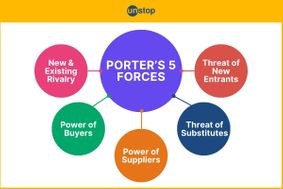


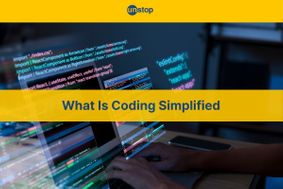
Comments
Add comment